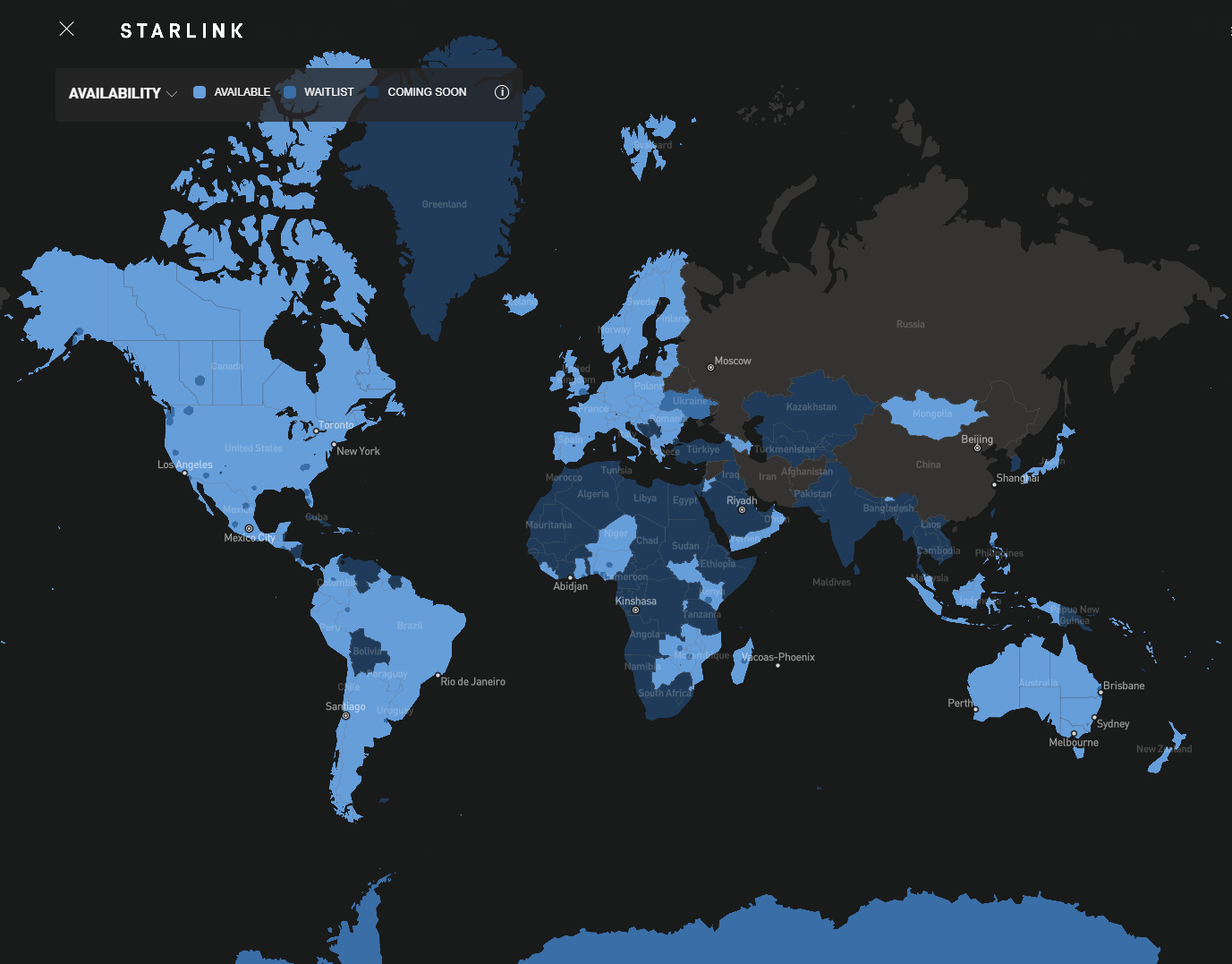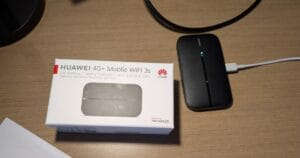It’s a Frequently Asked Question: How do we get online? Is it really good enough?
And the honest answer is, usually. Let me explain.
The Basics
The ship’s connectivity is through the SpaceX Starlink satellite system. As far cruise ships specifically, that Wikipedia article notes that “Starlink Maritime became available in July 2022 providing internet access on the open ocean, with speeds of 350 Mbit/s, requiring purchase of a maritime-grade $10,000 user terminal and a $5,000 monthly service fee.” Ouch!
What it doesn’t say is what the monthly bandwidth limit is, and what happens if the ship goes over that limit. It also doesn’t say what changes if a ship has more than one such terminal installed. We have eight such terminals. Does that mean $40,000/month? Do we get faster than 350 Mbit/s? Is the monthly cap multiplied by 8?
None of these questions have been answered. At least, not to us Residents.
The “Internet” from the satellites is then fed into a large local area network with hundreds of WiFi access points spread throughout the ship. Pretty much, you can walk anywhere on the ship, inside or out, and your phone (or tablet) “won’t” lose its connection. But, see “Limitations” below.
The Promise
The Villa Vie web site still says “High-Speed Internet: Seamless Global Connectivity” (as well as “No Hidden Fees Or Extra Gratuities”). The Business Center page says it has “high-speed internet and modern amenities, it’s your global office at sea — ensuring productivity meets adventure effortlessly.”
A page about the ship goes in a little more detail: “The Business Center on Villa Vie Odyssey is free for residents to use, providing a convenient workspace. For those seeking more privacy, private offices are available, offering a dedicated space for your professional needs. Whether you’re finalizing a deal or brainstorming the next big idea, our Business Center ensures you stay connected and productive on your voyage.”
We have been told that VOIP services have been given priority in the network, so that if there is a heavy load into the satellite(s), WiFi phone calling, Zoom conference, and the like get bandwidth priority, the idea being that such business calls should get priority in order to make business use more reliable, which is certainly a reasonable goal.
The Limitations, Ship-Side
The practical reality of all of this is, get several hundred Residents aboard, plus crew, plus ship operations, and the satellites become a bottleneck. The Internet will slow down at times.
Everyone comes back aboard after a particularly great day ashore, and everyone’s phones find WiFi and then start uploading the day’s photos and videos? It’s guaranteed to slow to a crawl. Even “priority” calls and Zoom chats will be affected. That’s just the reality of such a system.
Tip For Residents: Turn off your phone’s photo/video backup! Whether it’s to Apple, Google Photos, Onedrive/Dropbox, whatever, turn it off! I sure did. And when I want to get photos off my phone, I simply (gasp!) plug a USB cable between my phone and computer and suck them over. Easy as that. </tip>
Too, virtually all cruise ships have metal walls and fire doors. Cabins, even if they have windows, essentially become Faraday cages with very little WiFi (which is by design on very high radio frequencies that don’t penetrate metal well at all) “leaking” into the cabins.
To fix that, there’s a second network that feeds the televisions in the cabins. That network not only brings in satellite TV channels (which are separate from the satellite Internet), but also Internet signals. Very cleverly, the TVs can be, and have been, configured as WiFi access points, thus bringing WiFi inside cabins.
The catch to this? The TV has to be on for the access point to be active. To me, that’s a terrible design flaw. The workaround, so you don’t have to have the glow in your cabin at all times, is that there’s an “eco mode” that allows the screen to be turned off.
The Limitations, Starlink-Side
Starlink is not ubiquitous. Let’s start with their coverage map, where bright blue is access, darker blue within the light blue areas is “waitlist” (highly impacted areas with lots of demand), dark blue is “coming soon” (waiting for more satellites or regulatory approval), and dark gray (e.g., Russia, China) is …well… unmentioned, but your intuition that these areas coverage is “probably not available” is undoubtedly correct:

As I understand it, international waters aren’t really keyed black, as seems to be shown, as far as coverage is concerned; call it very likely light blue (yay!), except for Antarctica and probably the Arctic (boo!). But within the territorial waters off the countries in dark gray? Well, call coverage there “not guaranteed.”
We found out this morning that there are places where we just aren’t going get service, even when not near a communist country. Take, for instance, Bonaire, the middle (alphabetically) of the “ABC Islands” in the Caribbean, with the other two being Aruba and Curaçao. We woke up this morning to no Internet. The company got on the phone and found that Bonaire simply refused to license Starlink in their territory, full stop, which is bad for the country in that some cruise ships will surely refuse to come here just because of that.
What happens in Aruba and Curaçao remains to be seen; all three are protectorates of the Netherlands, though I “hear” that Bonaire is more independent than the others, so …well… “we’ll see” in the morning, when we arrive in Curaçao. I “expect” that we will have Starlink service in between in any case during the overnight hours.
My Own Use Case
For example, as an online publisher I generally need online access daily for research, posting to Facebook, getting order emails, interacting with readers, etc. Things get quite intense on Sundays (when I write This is True, get submissions from contributors — which sometimes takes some back and forth — and research questions as I write) and Mondays (when I research and write the Honorary Unsubscribe, other parts of the Premium newsletter, and — of course! — send it out).
It actually doesn’t use much bandwidth to send it out: software feeds the elements of the newsletter to one of my servers, and loads in the list of recipients; then the server has software that does a “mailmerge” of those components, and connects with an Email Service Provider to do the actual deliveries, so really the server is what needs bandwidth, and it has a nice wide pipe for its job.
But obviously, I need some connectivity with my server to provide it the ingredients. My backup in case of ship Internet failure is my phone, which has an international plan which covers me in most, but not all, countries, and the plan allows for the phone to be a hotspot to use that bandwidth. Though for Bonaire, it provided phone coverage …but not Internet.
I instituted a backup to the backup: a second international phone plan with a different carrier: one I knew had service on Bonaire. (For those of you who know how to pronounce the port city we are in: Kralendijk.) After getting online Sunday and getting a lot of that work done, it too failed — it simply kicked me off. Rumor was that everyone with AT&T-based phone service lost their connection, so perhaps that’s the carrier contract the second company uses here, and sometimes “stuff happens.”
Between the two there should be coverage in “most” countries. I’ll find out with more use if it’s worth keeping it as a secondary backup. If so, I’ll update the phone page linked above.
So the ship’s Internet failed (intentional provider outage), my backup failed, and my backup’s backup failed. I resigned myself to having to go ashore, finding a restaurant to park in that had WiFi for customers, and paying “rent” by having dinner there as I worked.
To make that efficient, I worked in my office to do everything else I needed to do before packing up. That means laying everything out for my software, etc.
Rescued
Until! Until I heard the voice of the company’s Hospitality Manager in the bullpen of the office area, and one word that he spoke caught my attention: “hotspot.” You won’t be surprised that I went out to offer my assistance, because I certainly knew what that was.
Sure enough, Oliver was setting up a cell-based hotspot [this one *], which was pretty much guaranteed to work because it was bought locally, here on Bonaire, at one of the local cell company’s stores. And I can see a cell tower through my office window! I helped him get it going, and asked if it was OK if I used it for a bit to get some work done.

“Not at all,” he said. “I got this for everyone at the Business Center who had work to do!”
I was actually boggled: the company did this at their own expense for those of us who work on board. That, dear readers, is absolutely amazing service! It is well after 9:00 p.m. (we leave at 10:00), and it’s still working while others are doing activities or heading to bed.
Best of all, what happens when (not if) this happens again? They don’t have to buy it again, they simply have to send someone ashore to a phone store to buy a new SIM, pop it in, and get it set up again. Except maybe in China, well known for its “Great Firewall”.
And hopefully that won’t be needed on a Sunday again, because we had to wait until Monday to get it. (We were scheduled for two days on Bonaire, Sunday and Monday — my two big working days.)
And I have to say, I’m impressed with the company’s initiative. I never had to pack up and drag my computer ashore, which I’m loathe to do because that puts it at risk of theft. Though I was heartened to hear from Residents who did go ashore that they felt like this was a wonderfully safe place.
Bottom Line
So how’s the Internet aboard …really? For me, the vast majority of time: Satisfactory!
But if you plan to stream a lot of movies, upload big videos to Youtube, or do online gaming — or other things that use a lot of bandwidth — your mileage may vary. It does get busy. Sometimes there’s a brief “skip” that interrupts video conferences, or disconnects completely and you have to reconnect. It’s simply the nature of satellite Internet, especially when the user antennas are mounted atop a tall, unstable, moving structure.
As noted above, I don’t know how much the Internet is costing the company, but they have indicated it’s coming in well above budget.
I will not be surprised if they decide that everyone gets a specific allotment per month, and if specific individuals go over that, they’ll have to pay by the GB for the extra. I doubt the average Resident will break whatever that allotment will be, especially if they take my advice above and turn off automatic photo/video uploading from their phones. (Hint, hint!)
For those doing business here, especially those of us who are paying for office space, I believe we will get a significant additional allotment.
And I expect an additional-additional allotment for those who are doing significant activity online that promotes the only workable solution for those interested in Residential Cruising: our company. I definitely don’t just mean this site, but also several other blogs and Youtube channels run by Residents (see the “Blogs” tab in the top menu for a list of them).
The company really is doing its part to make onboard Internet as good as possible, and they deserve the credit for working to Make It So.
Update: Just 15 minutes after pulling away from Bonaire, Starlink was up and running just fine, and continues to work in Curaçao.
Originally Published April 14, 2025 — Last Updated April 15, 2025

I’m hazy on exactly how a country can prohibit a satellite service from providing service to people who happen to be close to that country. *In* the country, you can ban the receiving gear, but it’s hard to see how you can ban the service per se. After all, land-based radio services routinely transmit to other countries where they are not welcome.
—
I’m sure there’s some sort of international law in play here. I know, for instance, that Starlink service wasn’t available in Ukraine a few years ago when Russia intensified its war against that country. Ukraine’s telecom minister (or some similar job title) tweeted that they wished they had Starlink, and Musk replied along the lines of, “I consider that a license” and had it turned on within 24 hours — and started shipping terminals to Ukraine. -rc
After doing a bit of research, the answer seems to be “political pressure”. Want to sell your cars here? Better follow our telecom rules. Plus the country may have influence with the US, which can then pressure SpaceX.
—
Sounds pretty likely to me. -rc
In my years at sea, we went from $10 per minute charge to about $1 per minute for calls or data. We connected a data link once or twice a day to squirt our operating database, and ship messages to shore. In the 90’s the crew was able to start using email, again, once or twice a day compressed messages. Only ships with lots of passengers could even consider having a full time internet link. I retired in 2008, so no telling what they have now. Starlink didn’t exist. How fortunate that you have the connectivity that you do. I just visited El Salvador, and my cellphone pretty much worked like it does at home with no roaming charges. Times do change.
—
They certainly do. On our last non-Residential cruise on NCL, for a mere 15-day cruise, we paid nearly $350 for one device to receive absolutely terrible Internet service. But each of us had to have it for our work — $690 on top of our $4,242.52 in tickets, not including gratuities. That’s really not the way to travel: never again, for us! -rc
Did you ever get a good resolution to the expensive equipment that was lost/stolen on that trip? I hope so!
—
Oh, it was definitely stolen, but never recovered, and never even acknowledged by NCL management. -rc
No wonder people were hooking up their own bootleg Starlink dishes on cruises!
—
Which, of course, are “Prohibited” items. -rc
I wonder if the hotspot device they bought has the ability to accept an eSim. That would be more convenient for the poor guy who goes to shore looking for a physical Sim card.
What a great thing the eSim is. I just started using them and will never buy another physical Sim unless I have to!
—
eSIMs are great for phones. Hotspot devices are too simple to use eSIMs — no cameras, no displays, no keyboards, no Internet connectivity without a SIM, etc. — and very often, online-sold data eSIMs are hugely overpriced compared to what’s sold locally. (I rejected a comment plugging one such site. The eSIM listed for Bonaire was $7 …for 1 entire GB of data. The local SIM was US$11 for 40 GB, which was more than enough for the time it was needed.) -rc
I don’t guess you are a SCUBA Diver — Bonaire is my favorite since it is nearly all Preserves and has a wonderful ecological attitude regarding the waters around the island. I hope you got some time ashore as it is an interesting island.
—
Heard of plenty of Residents going out to snorkel; didn’t happen to hear of any for Scuba. But alas, Sunday and Monday are my biggest work days, with the slowing factor of Internet problems, so I didn’t take time off to go out. -rc
Enjoy Curaçao, it’s a beautiful place to dive.
Thank you for such a well-written and complete report.
Thanks for this analysis. I’m planning to be on board for the China portion this coming September. It sounds like I better make plans to be without internet for at least a portion of that time, unless the “hotspot” idea works.
—
I wouldn’t count on a hotspot for access there: it would be connecting to Chinese cell towers. -rc
It’s a shame you have to use Starlink.
—
It’s what we have. -rc
Do you think connectivity would be challenging in Vietnam, Cambodia, Thailand, as it appears it would be in China? I made clients via zoom and it sounds like it could get patchy 🙁
—
It could be challenging, yes. The Starlink Coverage Map shows, for instance, we’ll be fine in Japan. Taiwan may be iffy, as well as Vietnam, Cambodia, and Thailand. Philippines, Indonesia, and Malaysia look good. The issue isn’t technology, but rather regulatory, as in Bonaire: we’ll probably be able to use services “near” blacked-out countries, but not while docked. It may prove frustrating here and there. -rc